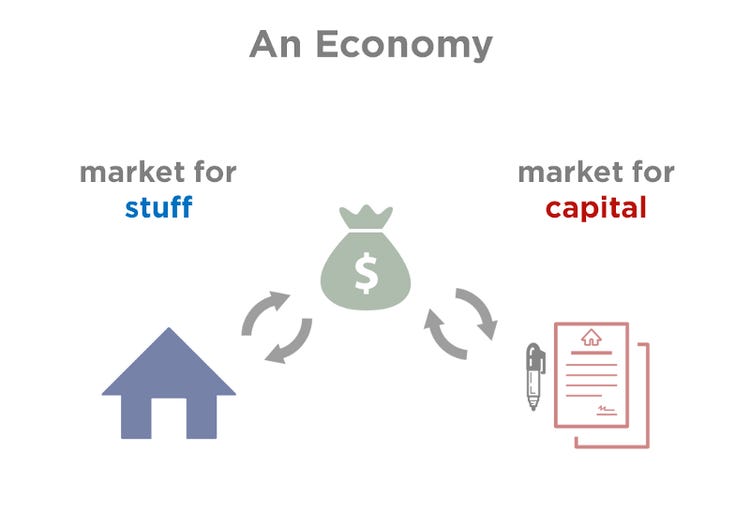The Unicorn Economy - The Capital Cycle (Part 2)
January 22nd, 2016
The Capital Cycle
An economy can be thought of as a relationship between two kinds of markets: a market for stuff, and a market for capital.
MONEY IN THE MIDDLE
In order for these two markets to have a relationship, we need money.
Money lets these two worlds ‘talk to each other’ by translating across boundaries. Money can do this because it plays the dual role of means of exchange (which is critical in the market for stuff) and as a store of value (which is critical in the market for capital).
This relationship is generally mutually beneficial, as the market for stuff enables people to go about their life creating, consuming and adding value to the great wheel of humanity, with the market for capital playing a supportive, but critical role.
The role of capital is to try to direct money in such a way as to ensure that the market for stuff has sufficient liquidity (money) but that the claims on all the stuff are priced (in terms of money) in such a way as to account for the uncertainty of the world.
The price of an asset is how much liquidity can be gained for that asset today in exchange for accepting the uncertainty about what it will be worth tomorrow.
The evolution of the two markets
Capital’s primary approach for doing its job is to evolve our understanding of the world (to learn) in such a way as to turn uncertainty (what we don’t know we don’t know) into risk (what we know we don’t know).
Turning uncertainty into risk generally increases liquidity, as people are only willing to exchange liquidity for something they understand.
By definition, risk is what can be understood (and priced), and uncertainty is what cannot.
While this evolutionary process is happening on the capital side, the market for stuff is also evolving, and that evolution (generally) generates uncertainty faster than capital can turn that uncertainty into risk. This leads to booms and busts.
BOOMS AND BUSTS
When market for stuff plays out in a way better than the expectations set in the capital markets, we experience rising prices for assets (the structure that makes the stuff) and greater liquidity. This feels good and we call it a boom.
When the market for stuff plays out in ways worse than expectations, prices fall and liquidity leaves the system. This feels bad and we call it a bust.
CYCLES
When we feel pleasure during a boom, being human, we chalk it up to something intrinsic about us. We become overconfident and the liquidity created during a boom inevitably goes back into the same assets which created the boom in the first place.
The problem is that the change in asset prices we experience today is a function of yesterday’s expectations. Today’s prices are based on expectations for tomorrow and by definition cannot contain the benefit they just received.
This overconfidence leads us to bake in expectations that are too optimistic, and abandon diversification at the very moment we need it most.
Eventually, tomorrow plays out in ways worse than we expected, and we become aware of our overconfidence and the depths of what we cannot know.
We become scared.
Liquidity is withdrawn and prices fall. Inevitably prices (and hence, expectations) fall to the point where we price in too much uncertainty and pain in the future, and bargains are to be had.
In this way cycles are born. Booms beget busts, and busts beget booms.
This dynamic plays itself out in all economies, and the Unicorn Economy is no different. However, in order to understand the Unicorn Economy, we need to introduce the notion of technology to our market for stuff.











